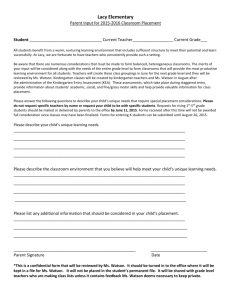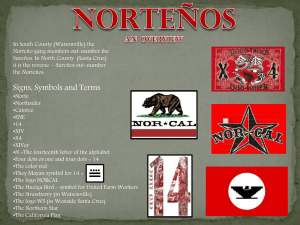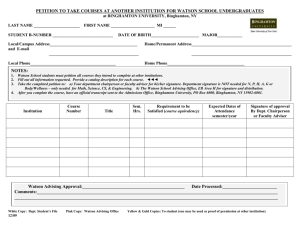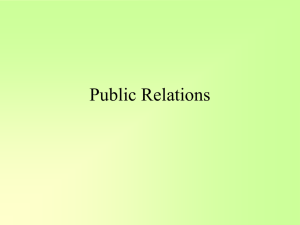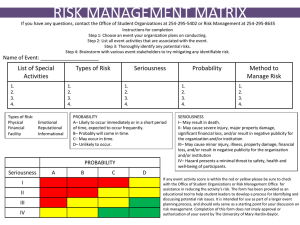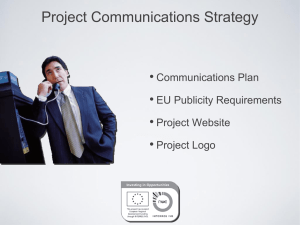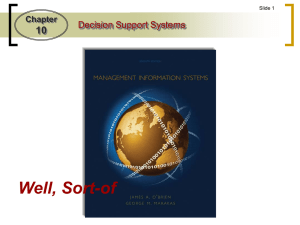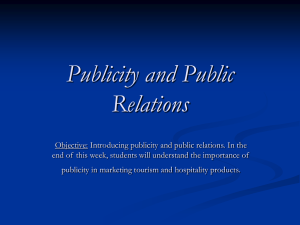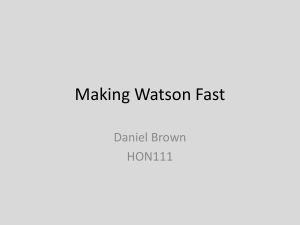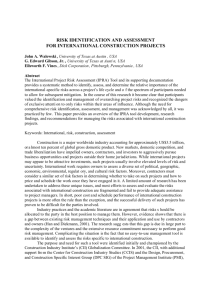HTML
advertisement
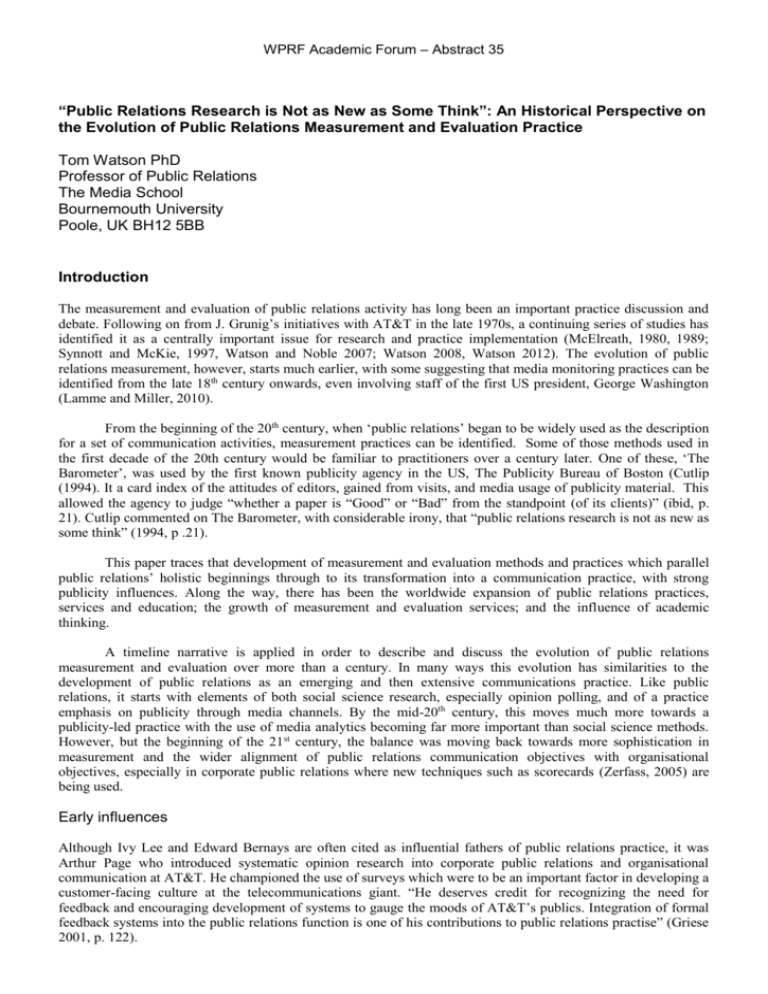
WPRF Academic Forum – Abstract 35 “Public Relations Research is Not as New as Some Think”: An Historical Perspective on the Evolution of Public Relations Measurement and Evaluation Practice Tom Watson PhD Professor of Public Relations The Media School Bournemouth University Poole, UK BH12 5BB Introduction The measurement and evaluation of public relations activity has long been an important practice discussion and debate. Following on from J. Grunig’s initiatives with AT&T in the late 1970s, a continuing series of studies has identified it as a centrally important issue for research and practice implementation (McElreath, 1980, 1989; Synnott and McKie, 1997, Watson and Noble 2007; Watson 2008, Watson 2012). The evolution of public relations measurement, however, starts much earlier, with some suggesting that media monitoring practices can be identified from the late 18th century onwards, even involving staff of the first US president, George Washington (Lamme and Miller, 2010). From the beginning of the 20th century, when ‘public relations’ began to be widely used as the description for a set of communication activities, measurement practices can be identified. Some of those methods used in the first decade of the 20th century would be familiar to practitioners over a century later. One of these, ‘The Barometer’, was used by the first known publicity agency in the US, The Publicity Bureau of Boston (Cutlip (1994). It a card index of the attitudes of editors, gained from visits, and media usage of publicity material. This allowed the agency to judge “whether a paper is “Good” or “Bad” from the standpoint (of its clients)” (ibid, p. 21). Cutlip commented on The Barometer, with considerable irony, that “public relations research is not as new as some think” (1994, p .21). This paper traces that development of measurement and evaluation methods and practices which parallel public relations’ holistic beginnings through to its transformation into a communication practice, with strong publicity influences. Along the way, there has been the worldwide expansion of public relations practices, services and education; the growth of measurement and evaluation services; and the influence of academic thinking. A timeline narrative is applied in order to describe and discuss the evolution of public relations measurement and evaluation over more than a century. In many ways this evolution has similarities to the development of public relations as an emerging and then extensive communications practice. Like public relations, it starts with elements of both social science research, especially opinion polling, and of a practice emphasis on publicity through media channels. By the mid-20th century, this moves much more towards a publicity-led practice with the use of media analytics becoming far more important than social science methods. However, but the beginning of the 21st century, the balance was moving back towards more sophistication in measurement and the wider alignment of public relations communication objectives with organisational objectives, especially in corporate public relations where new techniques such as scorecards (Zerfass, 2005) are being used. Early influences Although Ivy Lee and Edward Bernays are often cited as influential fathers of public relations practice, it was Arthur Page who introduced systematic opinion research into corporate public relations and organisational communication at AT&T. He championed the use of surveys which were to be an important factor in developing a customer-facing culture at the telecommunications giant. “He deserves credit for recognizing the need for feedback and encouraging development of systems to gauge the moods of AT&T’s publics. Integration of formal feedback systems into the public relations function is one of his contributions to public relations practise” (Griese 2001, p. 122). WPRF Academic Forum – Abstract 35 By the late 1930s and early 1940s in North America, two methods of measurement were being established that are still widely used. Batchelor (1938) provided two examples of the monitoring and interpretation of media coverage. The first was that the Roosevelt Administration gave close attention to both publicity dissemination and its reception. “In other words, it watches carefully all changes in the political attitudes of a community” (p. 212). Batchelor also referred to the extensive media monitoring operation of the city of Toledo, Ohio in the Great Depression. It measured some 72,000 media clippings from newspapers and found ninety-one per cent favourable to the city’s interests (p. 214). So it can be seen that at high levels of national and city government, measurement and evaluation were taking place using methods that are still in place today. At the same time, Tedlow (1979) identified the nexus between advertising and editorial space which was gained by press agents and publicists. This was later exemplified by Plackard & Blackmon (1947) who offered a fully worked example of Advertising Value Equivalence, many decades before it became a common (if dubious) practice. 1950s and 1960s In the 1950s and 1960s, there was a world-wide growth in public relations activity. In the UK, whose Institute of Public Relations was founded in 1948, there was evidence of discussion of evaluation in its Journal mainly proposing analysis of clippings and documents. But the increasing number of “how to” books on public relations produced in the UK and North America barely touched the topic. Analysis of the ‘program research and evaluation’ sub-section of Cutlip’s bibliography of public relations research (Cutlip, 1965) finds that there was little discussion of the methodology of measuring public relations activity or programmes, with the main emphasis on objective setting based on opinion research. Evaluation remained an elusive topic. IPR President Alan Eden-Green, writing the foreword in Ellis and Bowman’s Handbook of Public Relations (1963), posits PR as being “primarily concerned with communication” (Ellis & Bowman, 1963, foreword). Other texts at the time also focused on processes, but not planning, measurement or outcomes. In Germany, Albert Oeckl (1964) proposed three methods of research – publics and how they use media, content analysis and research on media effects. He was much more linked to the Bernaysian social science of PR than were UK practitioners. Increasing discussion The 1970s was a decade when books and articles addressing public relations evaluation started to appear. Measuring and Evaluating Public Relations Activities was published by the American Management Association in 1968 with seven articles on methods of measuring public relations results. Soon after, Robinson’s Public Relations and Survey Research (1969) was published. Pavlik says that “(Robinson) predicted that PR evaluation would move away from seat-of-the-pants approaches and toward “scientific derived knowledge” (1987, p. 66). Academics then began taking the lead. A conference in 1977 at the University of Maryland chaired by James E. Grunig, partnering with AT&T, was followed by the first scholarly special issue, ‘Measuring the Effectiveness of Public Relations,’ in Public Relations Review’s Winter 1977 edition, which featured papers from the conference. 1980s and 1990s – Debate widens Following on from the initial conference and academic journal discussion late in the previous decade, US journals came alive in the 1980s with papers from leading academics such as Glenn Broom, David Dozier, James Grunig, Douglass Newsom and Donald Wright. From the consultancy side, Lloyd Kirban of Burson Marsteller and Walter Lindenmann of Ketchum were prolific and drove the subject higher on the practitioner agenda. In 1990 Public Relations Review had a seminal special edition on evaluation, ‘Using Research to Plan and Evaluate Public Relations’ (Summer 1990). Widely cited, it showed that measurement and evaluation were consistently part of academic and professional discourse. By the early 1990s, public relations measurement and evaluation was a leading research and professional practice topic (McElreath, 1989; White & Blamphin, 1994; Synnott & McKie, 1997). There were major practitioner education initiatives in several developed countries, many linked closely to the Excellence Theory expression of public relations as communication management. In the US, the Institute for Public Relations Research and Education (now the Institute for Public Relations, IPR), harnessing Walter Lindenmann’s enthusiasm, published research and commentaries on establishing objectives and assessing results. The International Public Relations Association (IPRA) published its Gold Paper No.11: Public Relations Evaluation: WPRF Academic Forum – Abstract 35 Professional Accountability. In 1996, the Swedish PR body, Svenska Informationsförening, moved ahead of the debate at the time to report on Return on Communication, a form of Return on Investment that considered the creation of non-financial value through communications. New century In the first decade of the 21st century, other influences came upon PR planning, research and evaluation. Approaches based on scorecards (Zerfass, 2005) have moved the emphasis of evaluation of corporate communication away from the effects of media towards the development of communication strategies more closely related to organisational objectives where KPIs are measured, rather than outputs from communication activity. The decade ended with the adoption of The Barcelona Declaration of Measurement Principles at the European Measurement Summit in June 2010 (AMEC, 2010). This statement of seven principles of measurement of public relations activity favours measurement of outcomes, rather than media results, and the measurement of business results and of social media, but rejects AVEs as failing to indicate the value of public relations activity. It was a benchmark of basic measurement and evaluation practices and an attempt by the measurement service industry to define tenets of media analysis before addressing the challenges of both social media with its emphasis on ‘conversation’. The Barcelona Declaration demonstrates that PR measurement and evaluation is a major service business and greatly developed from the cuttings agencies of 50 to 100 years ago. References AMEC International Association for the Measurement and Evaluation of Communications, (2010). Barcelona Declaration of Measurement Principles: London: AMEC. Retrieved from: http://amecorg.com/2012/06/barcelona-declaration-of-measurement-principles/ [Accessed 26 June 2012] American Management Association, (1968). Measuring and Evaluating Public Relations Activities. New York: AMA, Management Bulletin No.110. Batchelor, B. (1938). Profitable public relations. New York: Harper and Brothers. Cutlip, S.M. (1965). A public relations bibliography, (2nd edn). Madison & Milwaukee: University of Wisconsin Press. Cutlip, S.M. (1994). The unseen power: Public relations, a history. Hillsdale, N.J.: Erlbaum Associates. Eden-Green, A. (1963). Foreword. In N. Ellis, & P. Bowman (Eds.), The handbook of public relations (p.5). London: George Harrap & Co. Griese, N.L. (2001). Arthur W. Page: Publisher, public relations pioneer, patriot. Atlanta: Anvil Publishers. IPRA International Public Relations Association, 1994. Gold Paper No.11: Public relations evaluation: professional accountability. London: IPRA. Lamme, M.O., & Miller, K.R. (2010). Removing the spin: Towards a new theory of public relations history. Journalism & Communication Monographs, 11(4), 281-362 L’Etang, J. (2004). Public relations in Britain. Mahwah, NJ: Lawrence Erlbaum Associates. McElreath, M.P. (1980). Priority research questions for public relations for the 1980s. New York: Foundation for Public Relations Research and Education. McElreath, M.P. (1989). Priority research questions in the field of public relations for the 1990s: trends over the past ten years and predictions for the future. Paper presented at the meeting of the Speech Communication Association, San Francisco. Oeckl, A. (1964). Handbuch der Public Relations. Munich: Süddeutscher Verlag. Pavlik, J. (1987). Public relations: What research tells us. Newbury Park, CA: Sage. Plackard, D.H., & Blackmon, C. (1947). Blueprint for public relations. New York: McGraw-Hill. Public Relations Review, (1990).Using research to plan and evaluate public relations. Summer 1990, xvi (2). Robinson, E.J. (1969). Public relations and survey research. New York: Appleton-Century-Crofts. SPRA Swedish Public Relations Association, (1996). Return on communications. Stockholm: Swedish Public Relation Association (Svenska Informationsförening). Synnott, G., & McKie, D. (1997). International issues in PR: researching research and prioritizing priorities. Journal of Public Relations Research, 9(4), 259-282. Tedlow, R.S. (1979). Keeping the corporate image: Public relations and business 1900-1950. Greenwich, CT: JAI Press. Watson, T. (2008). Public relations research priorities: A delphi study. Journal of Communication Management 12(2), 104-123 WPRF Academic Forum – Abstract 35 Watson, T. (2012). The evolution of public relations measurement and evaluation. Public Relations Review, 38, 390-398. Watson, T., & Noble P. (2007). Evaluating Public Relations (2nd ed.). London: Kogan Page. White, J., & Blamphin, J. (1994). Priorities for research in public relations in the United Kingdom. London: City University/Rapier Research. Zerfass, A. (2005). The corporate communications scorecard – a framework for managing and evaluating communication strategies. 12th International Public Relations Research Symposium (Bledcom), 1-3 July, 2005, Lake Bled, Slovenia.
